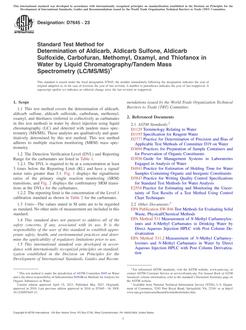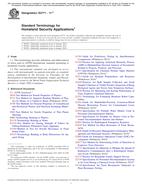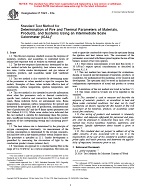1.1 This test method employs the signal-to-noise ratio to determine the sensitivity of a fluorescence measuring system in testing for the limit of detection (LOD) of quinine sulfate dihydrate in solution. The results obtained with quinine sulfate dihydrate in solution are suitable for specifying instrument performance on samples having excitation and fluorescence bands wider than 10 nm at or near room temperature.
1.1.1 This test method is not intended to be used as (1) a rigorous test of performance of instrumentation, or (2), to intercompare the quantitative performance of instruments of different design.Intercomparison of the LOD between instruments is commonly expressed as the ratio of the water Raman peak intensity to the root-mean-square (rms) noise as measured on a fluorometer using an excitation wavelength of 350 nm This test method uses the excitation and emission peak wavelengths for quinine sulfate dihydrate in solution, which are approximately 350 nm and 450 nm, respectively..
1.2 This test method has been applied to fluorescence-measuring systems utilizing non-laser, low-energy excitation sources. There is no assurance that extremely intense illumination will not cause photodecomposition of the compound suggested in this test method. For this reason, it is recommended that this test method not be indiscriminately employed with high intensity light sources. This test method is not intended to determine minimum detectable amounts of other materials. If this test method is extended to employ other chemical substances, the user should be aware of the possibility that these other substances may undergo decomposition or adsorption onto containers.
1.3 A typical LOD for conventional fluorometers using this test method is 1 ng of quinine sulfate per mL.
1.4 The suggested shelf life of a 1 mg/mL stock solution of quinine sulfate dihydrate is three months, when stored in the dark in a stoppered glass bottle.
1.5 This standard does not purport to address all of the safety problems, if any, associated with its use. It is the responsibility of the user of this standard to establish appropriate safety and health practices and determine the applicability of regulatory limitations prior to use.
Product Details
- Published:
- 02/01/2004
- Number of Pages:
- 3
- File Size:
- 1 file , 32 KB


